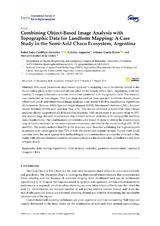Mostrar el registro sencillo del ítem
Combining Object-Based Image Analysis with Topographic Data for Landform Mapping: A Case Study in the Semi-Arid Chaco Ecosystem, Argentina
| dc.contributor.author | Castillejo-González, I.L. | |
| dc.contributor.author | Angueira de Prieto, Cristina | |
| dc.contributor.author | García-Ferrer Porras, Alfonso | |
| dc.contributor.author | Sánchez de la Orden, Manuel | |
| dc.date.accessioned | 2020-06-22T12:50:01Z | |
| dc.date.available | 2020-06-22T12:50:01Z | |
| dc.date.issued | 2019 | |
| dc.identifier.uri | http://hdl.handle.net/10396/20194 | |
| dc.description.abstract | This paper presents an object-based approach to mapping a set of landforms located in the fluvio-eolian plain of Rio Dulce and alluvial plain of Rio Salado (Dry Chaco, Argentina), with two Landsat 8 images collected in summer and winter combined with topographic data. The research was conducted in two stages. The first stage focused on basic-spectral landform classifications where both pixel- and object-based image analyses were tested with five classification algorithms: Mahalanobis Distance (MD), Spectral Angle Mapper (SAM), Maximum Likelihood (ML), Support Vector Machine (SVM) and Decision Tree (DT). The results obtained indicate that object-based analyses clearly outperform pixel-based classifications, with an increase in accuracy of up to 35%. The second stage focused on advanced object-based derived variables with topographic ancillary data classifications. The combinations of variables were tested in order to obtain the most accurate map of landforms based on the most successful classifiers identified in the previous stage (ML, SVM and DT). The results indicate that DT is the most accurate classifier, exhibiting the highest overall accuracies with values greater than 72% in both the winter and summer images. Future work could combine both, the most appropriate methodologies and combinations of variables obtained in this study, with physico-chemical variables sampled to improve the classification of landforms and even of types of soil. | es_ES |
| dc.format.mimetype | application/pdf | es_ES |
| dc.language.iso | eng | es_ES |
| dc.publisher | MDPI | es_ES |
| dc.rights | https://creativecommons.org/licenses/by/4.0/ | es_ES |
| dc.source | International Journal of Geo-Information 8(3), 132 (2019) | es_ES |
| dc.subject | Data mining algorithms | es_ES |
| dc.subject | DEM-derived variables | es_ES |
| dc.subject | Geoforms classification | es_ES |
| dc.subject | Landsat-8 imagery | es_ES |
| dc.subject | OBIA | es_ES |
| dc.title | Combining Object-Based Image Analysis with Topographic Data for Landform Mapping: A Case Study in the Semi-Arid Chaco Ecosystem, Argentina | es_ES |
| dc.type | info:eu-repo/semantics/article | es_ES |
| dc.relation.publisherversion | http://dx.doi.org/10.3390/ijgi8030132 | es_ES |
| dc.rights.accessRights | info:eu-repo/semantics/openAccess | es_ES |

